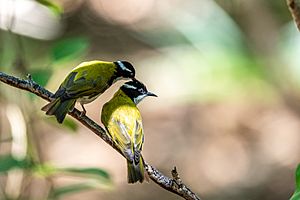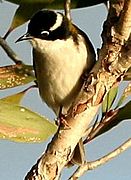White-throated honeyeater facts for kids
Quick facts for kids White-throated honeyeater |
|
|---|---|
 |
|
| Conservation status | |
| Scientific classification | |
| Genus: |
Melithreptus
|
| Species: |
albogularis
|
The white-throated honeyeater (Melithreptus albogularis) is a small bird. It belongs to the honeyeater family, called Meliphagidae. You can find this bird in New Guinea and parts of eastern and northern Australia. It is about 11.5 to 14.5 centimeters long. This bird has an olive-green back and a white belly. Its head is black, and it has a white or pale blue spot above its eye. A white stripe runs across the back of its neck.
Contents
About the White-throated Honeyeater
Scientists group living things into categories. This helps us understand how they are related. This is called taxonomy. The famous naturalist John Gould first described the white-throated honeyeater in 1848. Its scientific name, albogularis, comes from two Latin words. Albus means 'white', and gula means 'throat'.
Another naturalist, Charles Walter De Vis, described a similar bird in 1884. He called it Melithreptus vinitinctus. Later, scientists realized it was the same as the white-throated honeyeater.
There are two main types, or subspecies, of the white-throated honeyeater. One is called albogularis. It lives in northwestern Australia, the Northern Territory, and Cape York. The other is inopinatus. It lives in central and southeastern Queensland. The inopinatus subspecies is a bit larger. It also has a duller olive color on its back.
The white-throated honeyeater is part of a group of birds called Melithreptus. Many birds in this group are similar in size. Most have black heads, just like the white-throated honeyeater. They are all part of the larger honeyeater family. These birds often look for insects in leaves or at the top of trees. They also tend to gather in larger groups. You can often find them in open forests and grassy areas.
People have used other names for this bird. Sometimes it was called the white-chinned honeyeater. In the past, it was also known as the gay or gay-tinted honeyeater.
What the White-throated Honeyeater Looks Like
An adult white-throated honeyeater is about 11.5 to 14.5 centimeters long. Its upper body is olive-green or yellow-green. Its lower body and throat are white. It has a black head. There is a blue-white patch of skin above its eye. A white stripe goes across the back of its neck. The bird's beak is black. Its eyes are red-brown, and its legs are purple-brown. These birds make different sounds, or calls.
Birds That Look Similar
The Gilbert's honeyeater (Melithreptus chloropsis) lives in Western Australia. It also has a white patch above its eye. This can make it hard to tell apart from the white-throated honeyeater. However, these two birds do not live in the same areas. The eastern white-naped honeyeater (M. lunatus) looks similar. But it has a red patch above its eye instead of a white one.
Reproduction and Life Cycle
The white-throated honeyeater lays eggs and raises young across its home range. They usually breed from July or August to December. In northwestern Australia, they might breed until April. They can raise one or two groups of young each season.
Their nest is strong and shaped like a cup. They build it from bark and grasses. The nest is usually placed in the fork of a tree branch. The female bird lays two eggs. Each egg is about 18 by 14 millimeters in size. They are pinkish with brownish marks.
Gallery
See also
 In Spanish: Mielero goliblanco para niños
In Spanish: Mielero goliblanco para niños



